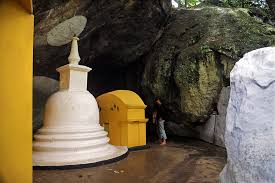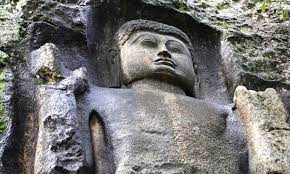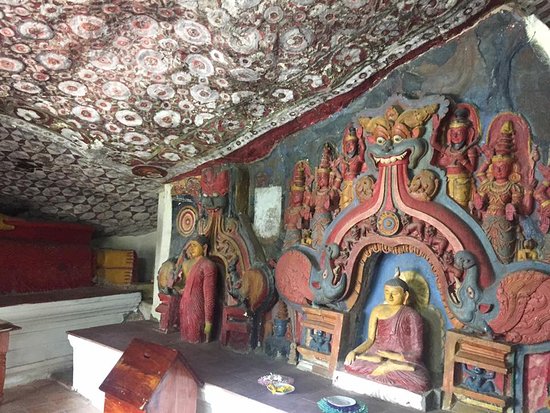Rock-hewn Buddha Statue of Dowa Cave Temple By Arundathie Abeysinghe

 Situated a few kilometers away from the ancient hamlet of Dowa (or Dhowa) on *Badulla-Bandarawela Road, approximately seven kilometers from Bandarawela town, the location of the Temple is breathtaking as it is situated at the foot of a hillock on the banks of a charming hill stream. The Temple buildings are located downhill with steep steps that lead to the famed cave temple. The hamlet has gained the name of “Dowa” as it is located within a ring of breathtaking mountains and a river which flows across the plateau.
Situated a few kilometers away from the ancient hamlet of Dowa (or Dhowa) on *Badulla-Bandarawela Road, approximately seven kilometers from Bandarawela town, the location of the Temple is breathtaking as it is situated at the foot of a hillock on the banks of a charming hill stream. The Temple buildings are located downhill with steep steps that lead to the famed cave temple. The hamlet has gained the name of “Dowa” as it is located within a ring of breathtaking mountains and a river which flows across the plateau.
The Temple is well-known due to the large Buddha Statue in the temple premises, considered as an example of Mahayana (a collection of Buddhist traditions: Zen Buddhism, Pure Land Buddhism and Tibetan Buddhism) sculpture.
According to chronicles, the Temple has been constructed during the reign of King Walagamba (103 BC and c. 89–77 BC) in the 1st century BC. This is one of several temples built by the King while taking refuge in the *Uva Province following an Indian invasion. The Cave at Dowa Temple had been one of the many safe places King Walagamba had resided during his 12-years of hiding before reclaiming the throne from the *Chola invaders. According to legends, the location of the Temple (especially the Cave) had been ideal to the King as it made a proper place of cover up with a 11 kilometers long secret tunnel known as Rawana Guhawa (cave of Rawana) guarded by a figure of a clay cobra statue.

According to locals, their ancestors have informed them of a tunnel in the temple premises with cobra images and cobras have protected the tunnel. But at present, it is cemented to avoid visitors from entering the tunnel as it is prone to cave-in which may endanger them. According to folklore, in the past, there had been a network of tunnels in Uva built by the legendary demon king *Rawana to hide *Sita invisibly.
According to legends, King Walagamba had used this tunnel to escape during enemy invasion and it had been connected to *Rawana Temple in Ella and *Bogoda Raja Maha Viharaya during the past. King Walagamba had used this tunnel as a secret escape route from Uva Province to the southern *Mahaweli River area.
There is a gigantic standing Buddha Statue carved into the rock face located below the road and the large carving of the Buddha stands at 39 feet (approximately 11 meters) etched on to the rock. The features of the face are serene and exudes a sense of peace. The rock cave in the Temple premises is a major tourist attraction. There is also a quaint white stupa (dagoba) within the temple premises enshrined with relics of an *Arhat. There are ancient and exquisite paintings of Kandyan art (*Kandyan Period art) which adorn the walls of the Temple. The large ornamental gateway at the entrance and the Image House (Budu Ge) of the temple is inside a rock cave and depicts Kandyan art and architecture. The construction of the Temple had commenced during the Anuradhapura period, but it had been completed during the Kandyan period. The *Bodhi Tree of the Temple is serenely located at mid-level, with the Budhu Gey (Image Houser) located at the base. There is a sermon hall located towards the side of the Bodhi Tree overlooking the flowing river. The shrine room of the Temple has two-dimensional Kandyan paintings with *Jataka stories built into rock which according to folklore were done during the Kandyan era by Kandyan Kings. The rock canopy of the Temple has floral paintings including lotus flowers as well as a rare painting called ‘Ath-Gon Satana’ (fight between a tusker and a bull).
A noteworthy feature of the Temple is the presence of images of cobras. There is a belief among locals that there is a cobra living in the Cave.
In 1996, the Temple was declared a protected heritage site and an archaeologically protected monument.

Location: Badulla – Bandarawela Road (about 7 kilometers from Bandarawela)
Image courtesy – tripadvisor.com & visitellea.com
- Anuradhapura – A major city in Sri Lanka (former Ceylon), the capital of Anuradhapura District. Anuradhapura was one of the ancient capitals of Sri Lanka famous for its well-preserved ruins of Sri Lankan civilization. Founded in the 4th century, Anuradhapura was the capital of Sri Lanka until the beginning of the 11th century. Anuradhapura is considered sacred to Buddhists and there are monasteries and stupas. Anuradhapura was declared as the “Sacred City of Anuradhapura” and a World Heritage Site by UNESCO in 1982.
- Arhat – According to Buddhism, an Arhat is one who has gained insight into the true nature of existence and achieved *Nirvana.
- Badulla – Situated in lower central hills, Badulla is the capital city of *Uva Province and Badulla District.
- Bo Tree – Also known as Bodhi Tree is a specific sacred fig tree (Ficus religiosa) under which the Buddha had attained *Enlightenment at Bodh Gaya in Bihar, India.
- Chola conquest – A military invasion of the *Anuradhapura Kingdom by the Chola Empire of Southern India, one of the longest ruling dynasties in world history. Initially, the Anuradhapura Kingdom was invaded in 993 AD and absorbed it into the Chola Empire of Southern India.
- Enlightenment – In Buddhism, Enlightenment is when a Buddhist finds the truth about life and stops being reborn as he/she has reached *Nirvana.
- Jataka stories – A voluminous body of literature native to India about the previous births of the Buddha.
- Kandyan Kingdom – The Kingdom was independent from the Portuguese and Dutch rule. Later, the Kingdom was colonized by the British in 1815.
- Mahaweli River – Sri Lanka’s longest river, 335 kilometers in length with a drainage basin of 10,448km2.
- Nirvana – It refers to a release from the cycle of death and rebirth, the ultimate spiritual goal of Buddhism.
- Princess Sita – According to Hinduism, the consort of God Rama. Princess Sita’s abduction by the demon King Rawana and subsequent rescue are the central incidents in the great Hindu epic Ramayana.
- Ramayana – Ancient Indian epic composed in 500 BCE to 100 BCE by Indian sage Valmiki. This epic composed in Sanskrit describes the conquest of Sri Lanka in 3000 BC by Prince Rama (Prince of Ayodhya, the eldest and favorite son of King Dasaratha, King of Ayodhya. Rama is an incarnation of God Vishnu) who fought with demon King Rawana (legendary emperor of Sri Lanka) to rescue his wife Princess Sita. Prince Rama was exiled with his wife Princess Sita due to a plot by his stepmother Kaikeyi. Princess Sita was abducted by King Rawana when Rama and Sita were in exile.
- Rawana – The mythical multi-headed demon-king in Hindu mythology Ramayana considered as a symbol of evil who fought and lost a series of epic battles against the hero Rama.
- Uva Province – Fourth largest province in Sri Lanka bordered by Central, Eastern and Southern provinces.
Bogoda Wooden Bridge – oldest surviving wooden bridge in Sri Lanka
By Arundathie Abeysinghe
Rawana Ella and Rawana Cave – entwined in myth and legend
By Arundathie Abeysinghe







